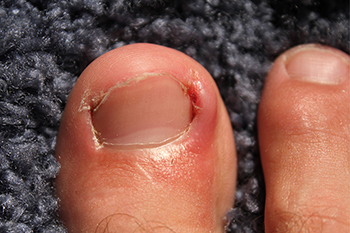
Trail hiking offers a serene escape into nature, where winding paths, towering trees, and breathtaking views create a peaceful experience. The rhythmic crunch of dirt beneath your boots and the fresh air can feel rejuvenating. However, long hikes on uneven terrain can take a toll on your feet, sometimes leading to painful ingrown toenails. This uncomfortable condition can develop when repeated pressure from steep climbs, descents, or ill-fitting hiking shoes causes the nail to grow into the surrounding skin. Wearing tight footwear, sweaty conditions, and prolonged toe impact can all contribute to irritation, swelling, and infection. If left untreated, an ingrown toenail can make every step painful. To keep hiking comfortably, wear properly fitted shoes and trim nails straight across. If you experience persistent pain, redness, or infection from an ingrown toenail, it is suggested that you see a podiatrist for expert care and relief.
Ingrown toenails can become painful if they are not treated properly. For more information about ingrown toenails, contact one of our podiatrists of Grobowski Foot & Ankle. our doctors can provide the care you need to keep you pain-free and on your feet.
Ingrown Toenails
Ingrown toenails occur when a toenail grows sideways into the bed of the nail, causing pain, swelling, and possibly infection.
Causes
- Bacterial infections
- Improper nail cutting such as cutting it too short or not straight across
- Trauma to the toe, such as stubbing, which causes the nail to grow back irregularly
- Ill-fitting shoes that bunch the toes too close together
- Genetic predisposition
Prevention
Because ingrown toenails are not something found outside of shoe-wearing cultures, going barefoot as often as possible will decrease the likeliness of developing ingrown toenails. Wearing proper fitting shoes and using proper cutting techniques will also help decrease your risk of developing ingrown toenails.
Treatment
Ingrown toenails are a very treatable foot condition. In minor cases, soaking the affected area in salt or antibacterial soaps will not only help with the ingrown nail itself, but also help prevent any infections from occurring. In more severe cases, surgery is an option. In either case, speaking to your podiatrist about this condition will help you get a better understanding of specific treatment options that are right for you.
If you have any questions please feel free to contact one of our offices located in Bellevue, Seattle, and Issaquah, WA, . We offer the newest diagnostic and treatment technologies for all your foot and ankle needs.
